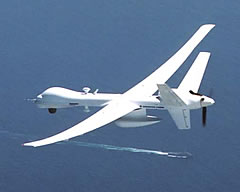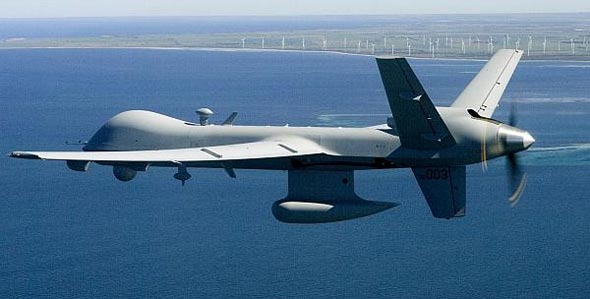General Atomics is building a derivative of the Predator B Unmanned Aerial System (UAS) designed for maritime applications. This platform dubbed Mariner is proposed by the team led by Lockheed Martin for the US Navy (broad area maritime surveillance systems) BAMS program. Mariner is a high altitude derivative of the Predator B (Reaper)system, designed to operate as an all-weather, multi-mission altitude agile, persistent intelligence, surveillance and reconnaissance asset supporting naval operations. Mariner shares several systems with the Reaper, including major fuselage elements, avionics, flight controls and powerplant (both are using the Honeywell TPE-331-10GD turbo prop engine with 49 kVA power generator).
One of the advanced features of the Mariner is its altitude agility. While satellite and, to certain extent, HALE systems are operating at high altitude, Mariner is designed to cruise at lower altitudes between 45,000 to 500 ft. Variable cruising altitude enables the Mariner’s operators to select the optimal altitude for best aerial coverage, reducing the effect of cloud cover and sea clutter that is seen at higher grazing angles. Furthermore, the Lockheed-GA team claims that altitude diversity allows sensors operators to achieve maximum probability to detect, classify and identify targets. In an event where a suspected target is detected, and requires a closer look, the Mariner will be able to descend to lower altitude, just like a manned aircraft, to perform positive threat classification (using ISAR, ESM or visual analysis), and visual identification below the weather, using electro-optical sensors. Using ISAR and EO sensors, the aircraft will be able to perform superstructure analysis. EO sensors will enable identification of flag of registry and name, monitor deck activity or look at exposed cargo and weapons status.
 Mariner is designed to carry out repeated altitude changes as part of its basic mission. To avoid air collisions when operating in uncontrolled airspace (such as over the ocean), the Mariner will be equipped with sense and avoid systems designed for visual flight rule (VFR) and low visibility conditions, flying instrument flight rule (IFR). General Atomics demonstrated the Mariner’s capabilities through extensive flight demonstrations performed in Australia.
Mariner is designed to carry out repeated altitude changes as part of its basic mission. To avoid air collisions when operating in uncontrolled airspace (such as over the ocean), the Mariner will be equipped with sense and avoid systems designed for visual flight rule (VFR) and low visibility conditions, flying instrument flight rule (IFR). General Atomics demonstrated the Mariner’s capabilities through extensive flight demonstrations performed in Australia.
Mariner has a wing span of 88 ft and length of 36 ft. It is designed for an operational ceiling of 50,000 ft and maximum airspeed of 230 knots. is designed to carry up to 4,000 lbs on six underwing hardpoints, in addition to the internal payload capacity of 1,350 lbs. Its maximum gross takeoff weight is 13,000 lbs, loaded with 6,000 lbs of fuel 6,000 and equipped with internal mission payload. The maximum endurance is 48 hours. Typical Mariner’s sensors suite includes FLIR System’s Star Safire HD Electro-Optical/Infrared (EO/IR) payload, the EDO/Elta 2022 SeaWatch multi-mode 360° maritime radar with integrated IFF Interrogator, ESM with Specific Emitter Identification (SEI) capability, SAAB R4A Automatic Identification System (AIS) and Link-16 Communications relay. The platform will also be able to carry various weapons and external stores (Sonobuoys) as external stores.

















